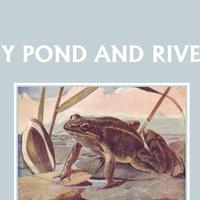CHAPTER 5. THE KINGFISHER
HUSH! Do not make a noise! There is a kingfisher sitting on the bough of the willow tree hanging over the river. If we once startle him, he will fly away and we shall not see him again.
How lovely he looks against the grey leaves. With his long beak and his stumpy tail he is not much larger than a sparrow, yet he seems to wear all the colours of the rainbow.
He has a bright blue streak down his back, his head and wings are a lovely green, with blue spots on the tips of the feathers. His beak is black. His chin and throat are white. He has a red streak behind his eye, with soft white feathers beyond, and his breast is shining like copper. Even his feet are red, and look quite gay against the dull branch.
He is peering down into the quiet pool under the willow, watching the fish swimming below. There! he has darted down to the water. Now he is up again with something in his mouth. It is a small minnow. He taps its head against the branch, and gulps it down, head first.
Once more, and still one more fish he catches in the same way. While he is eating the last, another kingfisher comes and perches by his side. This is his mate, who has been fishing a little way off. She is not quite so bright as he is, and has a little bit of red under her chin.
Now they are going home, and they fly away crying "Seep-seep-seep" as they go. They live in the trees and bushes by the side of the river. For you must always remember that birds do not live in nests. The nest is only a cradle for their eggs and their little ones. As soon as they are able to fly, the young birds leave it with their parents, and do not often live in a nest again, till they make one for their own eggs.
I do not think you will easily find a kingfisher's nest, so I must tell you about it. When the mother wants to lay her eggs, the kingfishers dig a tunnel in the bank, and when it is made they dart into it so fast that you cannot see where they go.
But if you could know where it is and dig down from above, you would find a snug chamber which measures about six inches across. At the bottom of this chamber are a number of fish bones which the old birds have put there. They are mixed up together so that they make a nice open floor, where the wet can get away. On the fish bones lie some shining white eggs. There will be seven, if the mother has laid as many as usual. And, if the birds are hatched, there will be seven little birds. Each bird will have all the lovely colours of which I have told you. The only difference between them and the old birds is that their beaks are shorter.
Though you may, perhaps, not find a kingfisher's nest, you will very likely see some young birds on the river. I was once out with a friend who was fishing, and while his rod was over the water, all at once two small kingfishers flew up and settled upon it. They rested a moment, and then flew on. He had only just thrown his fly again on to the water, when two more kingfishers flew up and sat on the rod. They, too, soon went on. It was clear that they were young birds just out of the nest and could not fly far.
The kingfishers are the brightest birds you can see on the river. They look so pretty among the green leaves, and hovering over the water, that if you have once seen them, you will want to see them again.

